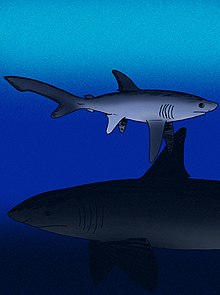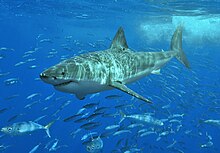
Carcharodon is a genus of sharks within the family Lamnidae, colloquially called the "white sharks." The only extant member is the great white shark. The extant species was preceded by a number of fossil (extinct) species including C. hubbelli and C. hastalis. The first appearance of the genus may have been as early as the Early Miocene or Late Oligocene.

Otodus megalodon, commonly known as megalodon, is an extinct species of giant mackerel shark that lived approximately 23 to 3.6 million years ago (Mya), from the Early Miocene to the Pliocene epochs. O. megalodon was formerly thought to be a member of the family Lamnidae and a close relative of the great white shark, but has been reclassified into the extinct family Otodontidae, which diverged from the great white shark during the Early Cretaceous.
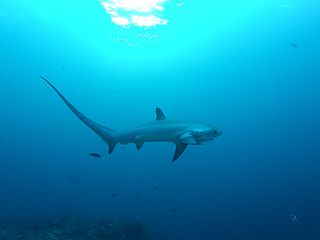
Thresher sharks are large mackerel sharks of the family Alopiidae found in all temperate and tropical oceans of the world; the family contains three extant species, all within the genus Alopias.
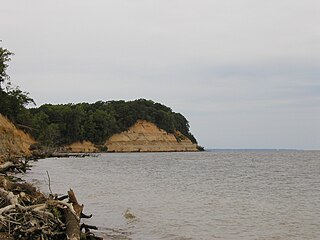
Calvert Cliffs State Park is a public recreation area in Lusby, Calvert County, Maryland, that protects a portion of the cliffs that extend for 24 miles along the eastern flank of the Calvert Peninsula on the west side of Chesapeake Bay from Chesapeake Beach southward to Drum Point. The state park is known for the abundance of mainly Middle Miocene sub-epoch fossils that can be found on the shoreline.

Otodus is an extinct, cosmopolitan genus of mackerel shark which lived from the Paleocene to the Pliocene epoch. The name Otodus comes from Ancient Greek ὠτ- and ὀδούς – thus, "ear-shaped tooth".

Sharks continually shed their teeth; some Carcharhiniformes shed approximately 35,000 teeth in a lifetime, replacing those that fall out. There are four basic types of shark teeth: dense flattened, needle-like, pointed lower with triangular upper, and non-functional. The type of tooth that a shark has depends on its diet and feeding habits.

Otodus angustidens is a species of prehistoric megatoothed sharks in the genus Otodus, which lived during the Oligocene and Miocene epochs about 33 to 22 million years ago. The largest individuals were about 11–12 metres (36–39 ft) long. This shark is related to another extinct megatoothed shark, Otodus megalodon.
Uatchitodon is an extinct genus of Late Triassic reptile known only from isolated teeth. Based on the structure of the teeth, Uatchitodon was probably a carnivorous archosauromorph. Folded grooves on the teeth indicate that the animal was likely venomous, with the grooves being channels for salivary venom. The teeth are similar to those of living venomous squamates such as Heloderma and venomous snakes. Uatchitodon is the earliest known venomous reptile.

Otodus chubutensis, meaning "ear-shaped tooth of Chubut", from Ancient Greek ὠτ and ὀδούς – thus, "ear-shaped tooth", is an extinct species of prehistoric megatoothed sharks in the genus Otodus, that lived during Early Miocene to Middle Miocene. The largest individuals were about 13.5 metres (44 ft) long. This shark is considered a close relative of the famous prehistoric megatoothed shark O. megalodon. However, as is the case with O. megalodon, the classification of this species is disputed.

Livyatan is an extinct genus of macroraptorial sperm whale containing one known species: L. melvillei. The genus name was inspired by the biblical sea monster Leviathan, and the species name by Herman Melville, the author of the famous novel Moby-Dick about a white bull sperm whale. It is mainly known from the Pisco Formation of Peru during the Tortonian stage of the Miocene epoch, about 9.9–8.9 million years ago (mya); however, finds of isolated teeth from other locations such as Chile, Argentina, United States (California), South Africa and Australia imply that either it or a close relative survived into the Pliocene, around 5 mya, and may have had a global presence. It was a member of a group of macroraptorial sperm whales and was probably an apex predator, preying on whales, seals and so forth. Characteristically of raptorial sperm whales, Livyatan had functional, enamel-coated teeth on the upper and lower jaws, as well as several features suitable for hunting large prey.

Otodus auriculatus is an extinct species of large sharks in the genus Otodus of the family Otodontidae, closely related to the sharks of the genus Otodus, and also closely related to the later species megalodon. The largest individuals were about 9.5 metres (31 ft) long. Its teeth were large, having coarse serrations on the cutting edge, and also with two large cusplets. The teeth can reach up to 130 millimetres (5.1 in), and belonged to a large "megatoothed" shark.

Carcharodon hubbelli, also known as Hubbell's white shark, is an extinct species of white shark that evolved between 8 and 5 million years ago during the Late Miocene to Early Pliocene epochs. This shark is a transitional species, showing intermediate features between the extant great white shark and the fossil white shark, Carcharodon hastalis. C. hubbelli appears to be geographically restricted to the Pacific Ocean, with fossils of C. hubbelli recovered from Peru, Chile, California, and New Zealand. This exclusive distribution suggests a Pacific origin for the great white shark.

Scaldicetus is an extinct genus of highly predatory macroraptorial sperm whale. Although widely used for a number of extinct physeterids with primitive dental morphology consisting of enameled teeth, Scaldicetus as generally recognized appears to be a wastebasket taxon filled with more-or-less unrelated primitive sperm whales.

The Choptank Formation is a geologic formation in Virginia and Maryland. It preserves fossils dating from the Miocene epoch of the Neogene period.

Cosmopolitodus is an extinct genus of mackerel shark that lived between thirty and one million years ago during the late Oligocene to the Early Pleistocene epochs. Its type species is Cosmopolitodus hastalis, the broad-tooth mako. In 2021, Isurus planus was reassigned to the genus, and thus became the second species C. planus. However, some researchers still consider both species of Cosmopolitodus as species of Carcharodon.

Parotodus, commonly known as the false-toothed mako shark, is an extinct genus of mackerel shark that lived approximately 53 to one million years ago during the Eocene and Pleistocene epochs. Its teeth, which are found worldwide, are often prized by fossil collectors due to their rarity. The scarcity of fossils is because Parotodus likely primarily inhabited open oceans far away from the continents.
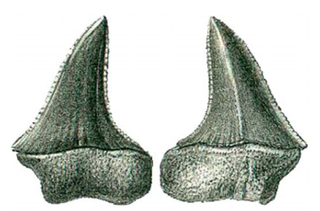
Carcharomodus escheri, commonly nicknamed the serrated mako shark or Escher's mako shark, is an extinct lamnid that lived during the Miocene. It has been formerly thought to have been the transitional between the broad-toothed "mako" Cosmopolitodus hastalis and the modern great white, but is now considered to be an evolutionary dead-end with the discovery of Carcharodon hubbelli. Fossil examples have been found along northern Atlantic coastlines and in parts of Western and Central Europe.

Alopias grandis is a species of giant thresher shark from the Miocene. Estimates calculated from teeth comparisons suggest the living animal was comparable in size to the extant great white shark. Remains generally consist of teeth, which have been found in the United States in the Calvert Formation of Virginia and Maryland, and in Beaufort County, South Carolina. They have also been found in the Miocene of Malta. It is unlikely it possessed the elongated tail lobe of modern thresher sharks. Some specimens in the Burdigalian show the beginnings of serrations, which are presumably transitional individuals between A. grandis and A.palatasi.

The Calvert Formation is a geologic formation in Maryland, Virginia, and Delaware. It preserves fossils dating back to the early to middle Miocene epoch of the Neogene period. It is one of the three formations which make up the Calvert Cliffs, all of which are part of the Chesapeake Group.
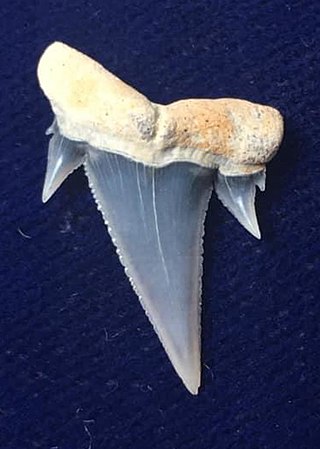
Carcharoides is an extinct genus of mackerel shark which lived during the Oligocene and Miocene epochs. It is a widespread genus, known from specimens in North and South America, Europe, Africa, and Australia. It is most common in the European portion of its range, being comparatively uncommon in other places. It is only known from isolated teeth, which are relatively delicate.

